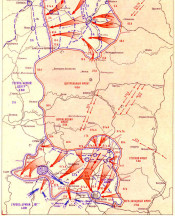
Memories of Soviet generals and marshals of the Battle of Kursk
One of the largest and bloodiest battles of the Great Patriotic War and World War II - the battle at the Kursk salient (also known as the Kursk bulge), or the Battle of Kursk, came to an end 76 years ago, on August 23, 1943. Some of the materials of the electronic collection Memory of the Great Victory on the Presidential Library’s portal are devoted to it. It includes official documents, photographs and newsreels, wartime newspapers, books, and first-hand accounts of participants.
The book The Battle at the Kursk Salient edited by Marshall of the Soviet Union K. S. Moskalenko is available in the Electronic Reading Room at Senate Square, 3 in St. Petersburg and in hundreds of centers of remote access to the Presidential Library’s resources, located in all regions of Russia and in many foreign countries.
Over time he recalled the events: “Over a period of 50 days, fights that were unprecedented as regards their fierceness and persistence took place on a relatively small land area of the Soviet-German front. The battle involved over 4 million men, about 70,000 guns and mortars, more than 13,000 tanks and self-propelled guns, and about 12,000 combat planes. <...> The command on both sides were well aware that the outcome of the battle would have a decisive influence on the results of the summer-autumn campaign of 1943 and also on the outcome of the Great Patriotic War and World War II. That is why the preparations were so thorough and took a long time”.
Other authors of the book are: Marshal of the Soviet Union I. Kh. Bagramyan, Chief Marshal of Armored Troops P. A. Rotmistrov, Marshal of Armored Troops O. A. Losik, Marshal of Aviation S. I. Rudenko.
“Although the Battle of Kursk did not last long the fights unprecedented in terms of fierceness took place during that period,” I. Kh. Bagramyan recalled.
P. A. Rotmistrov noted that in the summer 1943 the Soviet command used new tank tactics. The secret of the Red Army’s success was that being aware of the advantages of the German heavy tanks, Soviet tank crew “at a maximum speed crashed into the enemy’s armor formations and deprived the enemy of the advantages of heavy tanks in close-in battles”.
“During the Battle of Kursk, the Soviet Air Forces carried out about 118,000 sorties. From July 5 to August 23 Soviet pilots destroyed more than 3,700 German planes in air battles and at airfields. The Soviet Air Forces gained strategic dominance in the air and maintained it until the end of the war”- S. I. Rudenko observed.
Two books both entitled The Battle of Kursk by Major General I. V. Parotkin and Colonel I. I. Markin, which are also available in the electronic reading rooms of the Presidential Library, highlight some specific features of this battle.
I. V. Parotkin’s memoirs read in part: “The Battle of Kursk offered an original solution to the work organization on the home front. It had to provide everything necessary for a gigantic defensive battle and at the same time prepare troops for a counterattack without a long delay”.
I. I. Markin noted that the mass heroism of Soviet soldiers was the significant feature of the Battle of Kursk, especially its defensive period. The feats of Soviet soldiers during the fights against fascist tanks, especially new models of armored vehicles — heavy Tiger and Panther tanks and Ferdinand - the super-heavy self-propelled guns — are exemplary”.
In centers of remote access you can also study the collected works The Battle of Kursk edited by P. M. Beldiyev and S. M. Filippov, which feature the lines written by Marshal of the Victory G. K. Zhukov: “At 2.20 a.m. on July 5 everything was spinning marking the beginning of a powerful symphony of the greatest battle at the Kursk salient with distinctive sounds of heavy artillery and explosions of M-31 rockets”.
The Presidential Library’s portal provides access to the documentary film The Kursk Salient: Our Summer, which spotlights that the Battle of Kursk was the first major summer victory of the Red Army.
It was after the Battle at the Kursk Salient that the myth of ‘seasonal successes’ of the Soviet military was dispelled. You can read about this in the Order of Joseph Stalin published in the issue of Belyovskaya Pravda newspaper of July 29, 1943, which is part of the selection of newspapers of the Great Patriotic War available on the Presidential Library’s portal.
The Battle of Kursk lasted 50 days from July 5 to August 23, 1943 and came to an end with the decisive victory of the Soviet army. After that the Nazis were forced into strategic defence as offensive operations were no longer possible.

